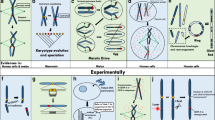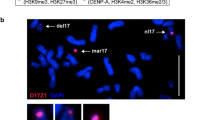Abstract
The centromere is essential for the faithful distribution of a cell's genetic material to subsequent generations. Despite intense scrutiny, the precise genetic and epigenetic basis for centromere function is still unknown. Here, we have used engineered dicentric human chromosomes to investigate mammalian centromere structure and function. We describe three classes of dicentric chromosomes isolated in different cell lines: functionally monocentric chromosomes, in which one of the two genetically identical centromeres is consistently inactivated; functionally dicentric chromosomes, in which both centromeres are consistently active; and dicentric chromosomes heterogeneous with respect to centromere activity. A study of serial single cell clones from heterogeneous cell lines revealed that while centromere activity is usually clonal, the centromere state (i.e. functionally monocentric or dicentric) in some lines can switch within a growing population of cells. Because pulsed field gel analysis indicated that the DNA at the centromeres of these chromosomes did not change detectably, this switching of the centromere state is most likely due to epigenetic changes. Inactivation of one of the two active centromeres in a functionally dicentric chromosome was observed in a percentage of cells after treatment with Trichostatin A, an inhibitor of histone deacetylation. This study provides evidence that the activity of human centromeres, while largely stable, can be subject to dynamic change, most likely due to epigenetic modification.
Similar content being viewed by others
References
Amor DJ, Choo KH (2002) Neocentromeres: role in human disease, evolution, and centromere study. Am J Hum Genet 71: 695–714.
Amor DJ, Kalitsis P, Sumer H, Choo KH (2004) Building the centromere: from foundation proteins to 3D organization. Trends Cell Biol 14: 359–368.
Belyaev N, Keohane AM, Turner BM (1996) Differential underacetylation of histones H2A, H3 and H4 on the inactive X chromosome in human female cells. Hum Genet 97: 573–578.
Black BE, Foltz DR, Chakravarthy S, Luger K, Woods VL Jr, Cleveland DW (2004) Structural determinants for generating centromeric chromatin. Nature 430: 578–582.
Brown CJ, Powers VE, Munroe DL, Sheinin R, Willard HF (1989) Gene on short arm of human X chromosome complements murine tsA1S9 DNA synthesis mutation. Somat Cell Mol Genet 15: 173–178.
Choo AKH (2000) Centromerization. Trends Cell Biol 10: 182–188.
Cimini D, Mattiuzzo M, Torosantucci L, Degrassi F (2003) Histone hyperacetylation in mitosis prevents sister chromatid separation and produces chromosome segregation defects. Mol Biol Cell 14: 3821–3833.
Cleveland DW, Mao Y, Sullivan KF (2003) Centromeres and kinetochores: from epigenetics to mitotic checkpoint signaling. Cell 112: 407–421.
Csink AK, Henikoff S (1998) Something from nothing: the evolution and utility of satellite repeats [see comments]. Trends Genet 14: 200–204.
Earnshaw WC, Ratrie H, Stetten G (1989) Visualization of centromere proteins CENP-B and CENP-C on a stable dicentric chromosome in cytological spreads. Chromosoma 98: 1–12.
Ekwall K, Olsson T, Turner BM, Cranston G, Allshire RC (1997) Transient inhibition of histone deacetylation alters the structural and functional imprint at fission yeast centromeres. Cell 91: 1021–1032.
Fisher AM, Al-Gazali et al. (1997) Centromeric inactivation in a dicentric human Y;21 translocation chromosome. Chromosoma 106: 199–206.
Grimes BR, Babcock J, Rudd MK, Chadwick B, Willard HF (2004) Assembly and characterization of heterochromatin and euchromatin on human artificial chromosomes. Genome Biol 5: R89.
Haaf T, Ward DC (1994) Structural analysis of alpha satellite DNA and centromere proteins using extended chromatin and chromosomes. Hum Mol Genet 3: 697–709.
Hall IM, Shankaranarayana GD, Noma K, Ayoub N, Cohen A, Grewal SI (2002) Establishment and maintenance of a heterochromatin domain. Science 297: 2232–2237.
Hall IM, Noma K, Grewal SI (2003) RNA interference machinery regulates chromosome dynamics during mitosis and meiosis in fission yeast. Proc Natl Acad Sci USA 100: 193–198.
Harrington JJ, Van Bokkelen G, Mays RW, Gustashaw K, Willard HF (1997) Formation of de novo centromeres and construction of first-generation human artificial microchromosomes [see comments]. Nat Genet 15: 345–355.
Henikoff S, Ahmad K, Malik HS (2001) The centromere paradox: stable inheritance with rapidly evolving DNA. Science 293: 1098–1102.
Henikoff S, Furuyama T, Ahmad K (2004) Histone variants, nucleosome assembly and epigenetic inheritance. Trends Genet 20: 320–326.
Higgins AW, Schueler MG, Willard HF (1999) Chromosome engineering: generation of mono- and dicentric isochromosomes in a somatic cell hybrid system. Chromosoma 108: 256–265.
Ikeno M, Grimes B, Okazaki T et al. (1998) Construction of YAC-based mammalian artificial chromosomes. Nat Biotechnol 16: 431–439.
Jeppesen P, Turner BM (1993) The inactive X chromosome in female mammals is distinguished by a lack of histone H4 acetylation, a cytogenetic marker for gene expression. Cell 74: 281–289.
Jeppesen P, Mitchell A, Turner B, Perry P (1992) Antibodies to defined histone epitopes reveal variations in chromatin conformation and underacetylation of centric heterochromatin in human metaphase chromosomes. Chromosoma 101: 322–332.
Karpen GH, Allshire RC (1997) The case for epigenetic effects on centromere identity and function. Trends Genet 13: 489–496.
Koshland D, Rutledge L, Fitzgerald-Hayes M, Hartwell LH (1987) A genetic analysis of dicentric minichromosomes in Saccharomyces cerevisiae. Cell 48: 801–812.
Lander ES, Linton LM et al. (2001) Initial sequencing and analysis of the human genome. Nature 409: 860–921.
Mahtani MM, Willard HF (1990) Pulsed-field gel analysis of alpha satellite DNA at the human X chromosome centromere: high frequency polymorphisms and array size estimate. Genomics 7: 607–613.
Maison C, Bailly D, Peters AH et al. (2002) Higher-order structure in pericentric heterochromatin involves a distinct pattern of histone modification and an RNA component. Nat Genet 30: 329–334.
McClintock B (1939) The behavior in successive nuclear divisions of a chromosome broken in meiosis. Proc Natl Acad Sci 25: 405–416.
Murphy TD, Karpen GH (1998) Centromeres take flight: alpha satellite and the quest for the human centromere. Cell 93: 317–320.
Nagaraja R, MacMillan S et al. (1997) X chromosome map at 75-kb STS resolution, revealing extremes of recombination and GC content. Genome Res 7: 210–222.
Nakano M, Okamoto Y, Ohzeki J, Masumoto H (2003) Epigenetic assembly of centromeric chromatin at ectopic alpha-satellite sites on human chromosomes. J Cell Sci 116: 4021–4034.
O'Keefe RT, Henderson SC, Spector DL (1992) Dynamic organization of DNA replication in mammalian cell nuclei: spatially and temporally defined replication of chromosome-specific alpha-satellite DNA sequences. J Cell Biol 116: 1095–1110.
Page SL, Shaffer LG (1998) Chromosome stability is maintained by short intercentromeric distance in functionally dicentric human Robertsonian translocations. Chromosom Res 6: 115–122.
Palmer DK, O'Day K, Wener MH, Andrews BS, Margolis RL (1987) A 17-kD centromere protein (CENP-A) copurifies with nucleosome core particles and with histones. J Cell Biol 104: 805–815.
Rea S, Eisenhaber F et al. (2000) Regulation of chromatin structure by site-specific histone H3 methyltransferases. Nature 406: 593–599.
Ross MT, Graham DV et al. (2005) The DNA sequence of the human X chromosome. Nature 434: 325–337.
Rudd MK, Willard HF (2004) Analysis of the centromeric regions of the human genome assembly. Trends Genet 20: 529–533.
Rudd MK, Mays RW, Schwartz S, Willard HF (2003) Human artificial chromosomes with alpha satellite-based de novo centromeres show increased frequency of nondisjunction and anaphase lag. Mol Cell Biol 23: 7689–7697.
Schaar BT, Chan GK, Maddox P, Salmon ED, Yen TJ (1997) CENP-E function at kinetochores is essential for chromosome alignment. J Cell Biol 139: 1373–1382.
Schueler MG, Higgins AW, Nagaraja R et al. (2000) Large-insert clone/STS contigs in Xq11–q12, spanning deletions in patients with androgen insensitivity and mental retardation. Genomics 66: 104–109.
Schueler MG, Higgins AW, Rudd MK, Gustashaw K, Willard HF (2001) Genomic and genetic definition of a functional human centromere. Science 294: 109–115.
Shelby RD, Vafa O, Sullivan KF (1997) Assembly of CENP-A into centromeric chromatin requires a cooperative array of nucleosomal DNA contact sites. J Cell Biol 136: 501–513.
Shelby RD, Monier K, Sullivan KF (2000) Chromatin assembly at kinetochores is uncoupled from DNA replication. J Cell Biol 151: 1113–1118.
Steiner N, Clarke L (1994) A novel epigenetic effect can alter centromere function in fission yeast. Cell 79: 865–874.
Sullivan B, Karpen G (2001) Centromere identity in Drosophila is not determined in vivo by replication timing. J Cell Biol 154: 683–690.
Sullivan BA, Karpen GH (2004) Centromeric chromatin exhibits a histone modification pattern that is distinct from both euchromatin and heterochromatin. Nat Struct Mol Biol 11: 1076–1083.
Sullivan BA, Schwartz S (1995) Identification of centromeric antigens in dicentric Robertsonian translocations: CENP-C and CENP-E are necessary components of functional centromeres. Hum Mol Genet 5: 2189–2198.
Sullivan BA, Warburton PE (1999) Studying progression of vertebrate chromosomes through mitosis by immunofluorescence and FISH. In: Bickmore WA, ed. Chromosome Structural Analysis—A Practical Approach. Oxford: Oxford University Press, pp. 81–101.
Sullivan BA, Willard HF (1998) Stable dicentric X chromsomes with two functional centromeres. Nat Genet 20: 227–228.
Sullivan BA, Wolff DJ, Schwartz S (1994a) Analysis of centromeric activity in Robertsonian translocations: implications for a functional acrocentric hierarchy. Chromosoma 103: 459–467.
Sullivan KF, Hechenberger M, Masri K (1994b) Human CENP-A contains a histone H3 related histone fold domain that is required for targeting to the centromere. J Cell Biol 127: 581–592.
Taddei A, Maison C, Roche D, Almouzni G (2001) Reversible disruption of pericentric heterochromatin and centromere function by inhibiting deacetylases. Nat Cell Biol 3: 114–120.
Therman E, Sarto GE, Patau K (1974) Apparently isodicentric but functionally monocentric X chromosome in man. Am J Hum Genet 26: 83–92.
Therman E, Trunca C, Kuhn EM, Sarto GE (1986) Dicentric chromosomes and the inactivation of the centromere. Hum Genet 72: 191–195.
Tyler-Smith C, Oakey RJ et al. (1993) Localization of DNA sequences required for human centromere function through an analysis of rearranged Y chromosomes. Nat Genet 5: 368–375.
Vianna-Morgante AM, Rosenberg C (1986) Deletion of the centromere as a mechanism for achieving stability of a dicentric chromosome. Cytogenet Cell Genet 42: 119–122.
Warburton PE (2004) Chromosomal dynamics of human neocentromere formation. Chromosom Res 12: 617–626.
Warburton P, Willard H (1996) Evolution of centromeric alpha satellite DNA: molecular organization within and between human and primate chromosomes. In: Jackson M, Strachan T, Dover G, eds. Human Genome Evolution. Oxford, UK: BIOS Scientific Publishers, pp. 121–145.
Warburton PE, Cooke CA et al. (1997) Immunolocalization of CENP—A suggests a distinct nucleosome structure at the inner kinetochore plate of active centromeres. Curr Biol 7: 901–904.
Waye JS, Willard HF (1985) Chromosome-specific alpha satellite DNA: nucleotide sequence analysis of the 2.0 kilobasepair repeat from the human X chromosome. Nucleic Acids Res 12: 2731–2743.
Waye JS, Mitchell AR, Willard HF (1988) Organization and genomic distribution of “82H” alpha satellite DNA. Hum Genet 78: 27–32.
Wevrick R, Willard HF (1989) Long-range organization of tandem arrays of alpha satellite DNA at the centromeres of human chromosomes: High frequency array-length polymorphism and meiotic stability. Proc Natl Acad Sci U S A 86: 9394–9398.
Wiens GR, Sorger PK (1998) Centromeric chromatin and epigenetic effects in kinetochore assembly. Cell 93: 313–316.
Wood KW, Sakowicz R, Goldstein LS, Cleveland DW (1997) CENP-E is a plus end-directed kinetochore motor required for metaphase chromosome alignment. Cell 91: 357–366.
Yen TJ, Compton DA, Wise D et al. (1991) CENP-E, a novel human centromere-associated protein required for progression from metaphase to anaphase. EMBO J 10: 1245–1254.
Yen TJ, Li G, Schaar BT, Szilak I, Cleveland DW (1992) CENP-E is a putative kinetochore motor that accumulates just before mitosis. Nature 359: 536–539.
Author information
Authors and Affiliations
Corresponding author
Rights and permissions
About this article
Cite this article
Higgins, A.W., Gustashaw, K.M. & Willard, H.F. Engineered human dicentric chromosomes show centromere plasticity. Chromosome Res 13, 745–762 (2005). https://doi.org/10.1007/s10577-005-1009-2
Received:
Revised:
Published:
Issue Date:
DOI: https://doi.org/10.1007/s10577-005-1009-2




